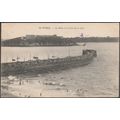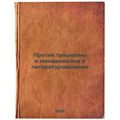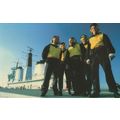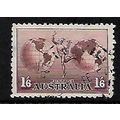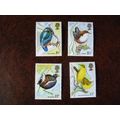Freud, Lucian - Naked Portrait, 1972-3 - art postcard (Tate)
- Condition : Used
- Dispatch : 2 Days
- Brand : None
- ID# : 200644315
- Quantity : 1 item
- Views : 2357
- Location : United Kingdom

- Seller : justthebook (+1703)
- Barcode : None
- Start : Thu 06 May 2021 16:55:54 (BST)
- Close : Run Until Sold
- Remain : Run Until Sold
More Listings from This Seller view all
Seller's Description
- Art Postcard
- Work of art title: Naked Portrait, 1972-3
- Artist (if known): Lucian Freud
- Media or other details: oil on canvas
- Publisher / Gallery: Tate Gallery
- Postally used: no
- Stamp & postmark details (if relevant):
- Size: Modern
- Notes & condition details:
NOTES:
Size: 'Modern' is usually around 6in x 4in or larger / 'Old Standard' is usually around 5½in x 3½in. Larger sizes mentioned, but if you need to know the exact size please ask as this can vary.
All postcards are not totally new and are pre-owned. It's inevitable that older cards may show signs of ageing and use, particularly if sent through the post. Any faults other than normal ageing are noted.
Stock No.: A1280
Please ask if you need any other information and I will do the best I can to answer.
------------------------------------------------
Postage and packing charge should be showing for your location (contact if not sure).
UK - PayPal, Cheque (from UK bank) or postal order
I will give a full refund if you are not fully satisfied with the postcard.
----------------------------------------------
Lucian Michael Freud, OM CH[1] (/frɔɪd/; 8 December 1922 – 20 July 2011) was a British painter and draughtsman, specialising in figurative art, and is known as one of the foremost 20th-century portraitists. He was born in Berlin, the son of Jewish architect Ernst L. Freud and the grandson of Sigmund Freud. Freud got his first name "Lucian" from his mother in memory of the ancient writer Lucian of Samosata. His family moved to England in 1933 to escape the rise of Nazism. From 1942 to 1943 he attended Goldsmiths College, London. He served at sea with the British Merchant Navy during the Second World War.
His early career as a painter was influenced by surrealism, but by the early 1950s his often stark and alienated paintings tended towards realism.[2] Freud was an intensely private and guarded man, and his paintings, completed over a 60-year career, are mostly of friends and family. They are generally sombre and thickly impastoed, often set in unsettling interiors and urban landscapes. The works are noted for their psychological penetration and often discomforting examination of the relationship between artist and model. Freud worked from life studies, and was known for asking for extended and punishing sittings from his models.[3]
...
Freud's early paintings, which are mostly very small, are often associated with German Expressionism (an influence he tended to deny) and Surrealism in depicting people, plants and animals in unusual juxtapositions. Some very early works anticipate the varied flesh tones of his mature style, for example Cedric Morris (1940, National Museum of Wales), but after the end of the war he developed a thinly painted very precise linear style with muted colours, best known in his self-portrait Man with Thistle (1946, Tate)[14] and a series of large-eyed portraits of his first wife, Kitty Garman, such as Girl with a Kitten (1947, Tate).[15] These were painted with tiny sable brushes and evoke Early Netherlandish painting.[16]
From the 1950s, he began to focus on portraiture, often nudes (though his first full-length nude was not painted until 1966),[17] to the almost complete exclusion of everything else, and by the middle of the decade developed a much more free style using large hog's-hair brushes, concentrating on the texture and colour of flesh, and much thicker paint, including impasto. Girl with a White Dog, 1951–1952, (Tate) is an example of a transitional work in this process, sharing many characteristics with paintings before and after it, with relatively tight brushwork and a middling size and viewpoint. He would often clean his brush after each stroke when painting flesh, so that the colour remained constantly variable. He also started to paint standing up, which continued until old age, when he switched to a high chair.[17] The colours of non-flesh areas in these paintings are typically muted, while the flesh becomes increasingly highly and variably coloured. By about 1960, Freud had established the style that he would use, with some changes, for the rest of his career. The later portraits often use an over life-size scale, but are of mostly relatively small heads or in half-lengths. Later portraits are often much larger. In his late career he often followed a portrait by producing an etching of the subject in a different pose, drawing directly onto the plate, with the sitter in his view.[18]
Freud's portraits often depict only the sitter, sometimes sprawled naked on the floor or on a bed or alternatively juxtaposed with something else, as in Girl With a White Dog (1951–52) and Naked Man With Rat (1977–78).[19] According to Edward Chaney, "The distinctive, recumbent manner in which Freud poses so many of his sitters suggests the conscious or unconscious influence both of his grandfather's psychoanalytical couch and of the Egyptian mummy, his dreaming figures, clothed or nude, staring into space until (if ever) brought back to health and/or consciousness. The particular application of this supine pose to freaks, friends, wives, mistresses, dogs, daughters and mother alike (the latter regularly depicted after her suicide attempt and eventually, literally mummy-like in death), tends to support this hypothesis."[20]
The use of animals in his compositions is widespread, and often he features a pet and its owner. Other examples of portraits with both animals and people in Freud's work include Guy and Speck (1980–81), Eli and David (2005–06) and Double Portrait (1985–86).[21] He had a special passion for horses, having enjoyed riding at school in Dartington, where he sometimes slept in the stables.[22] His portraits solely of horses include Grey Gelding (2003), Skewbald Mare (2004), and Mare Eating Hay (2006). Wilting houseplants feature prominently in some portraits, especially in the 1960s, and Freud also produced a number of paintings purely of plants.[23] Other regular features included mattresses in earlier works, and huge piles of the linen rags with which he used to clean his brushes in later ones.[24] Some portraits, especially in the 1980s, have very carefully painted views of London roofscapes seen through the studio windows.[25]
Freud's subjects, who needed to make a very large and uncertain commitment of their time, were often the people in his life; friends, family, fellow painters, lovers, children. He said, "The subject matter is autobiographical, it's all to do with hope and memory and sensuality and involvement, really."[26] However the titles were mostly anonymous, and the identity of the sitter not always disclosed; the Duke and Duchess of Devonshire had a portrait of one of Freud's daughters as a baby for several years before he mentioned who the model was. In the 1970s Freud spent 4,000 hours on a series of paintings of his mother, about which art historian Lawrence Gowing observed "it is more than 300 years since a painter showed as directly and as visually his relationship with his mother. And that was Rembrandt."[27]
Freud painted from life, and usually spent a great deal of time with each subject, demanding the model's presence even while working on the background of the portrait. Ria, Naked Portrait 2007, a nude completed in 2007, required sixteen months of work, with the model, Ria Kirby, posing all but four evenings during that time. With each session averaging five hours, the painting took approximately 2,400 hours to complete.[28] A rapport with his models was necessary, and while at work, Freud was characterised as "an outstanding raconteur and mimic".[28] Regarding the difficulty in deciding when a painting is completed, Freud said that "he feels he's finished when he gets the impression he's working on somebody else's painting".[28] Paintings were divided into day paintings done in natural light and night paintings done under artificial light, and the sessions, and lighting, were never mixed.[29]
It was Freud's practice to begin a painting by first drawing in charcoal on the canvas. He then applied paint to a small area of the canvas, and gradually worked outward from that point. For a new sitter, he often started with the head as a means of "getting to know" the person, then painted the rest of the figure, eventually returning to the head as his comprehension of the model deepened.[28] A section of canvas was intentionally left bare until the painting was finished.[28] The finished painting is an accumulation of richly worked layers of pigment, as well as months of intense observation.[28]
Listing Information
| Listing Type | Gallery Listing |
| Listing ID# | 200644315 |
| Start Time | Thu 06 May 2021 16:55:54 (BST) |
| Close Time | Run Until Sold |
| Starting Bid | Fixed Price (no bidding) |
| Item Condition | Used |
| Bids | 0 |
| Views | 2357 |
| Dispatch Time | 2 Days |
| Quantity | 1 |
| Location | United Kingdom |
| Auto Extend | No |


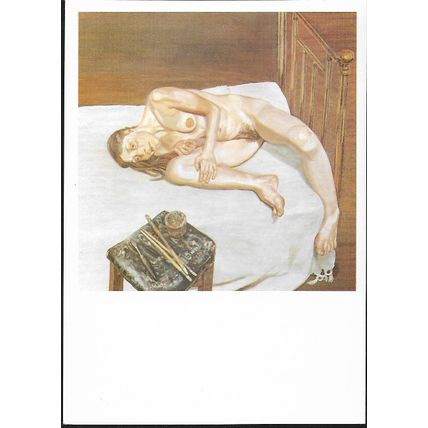

 for 1 item(s)
for 1 item(s)







